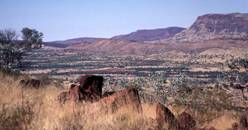 A 3.46 billion year-old rock suggests the Earth’s atmosphere was as oxygenated then as it is today, writes Sarah Day
A 3.46 billion year-old rock suggests the Earth’s atmosphere was as oxygenated then as it is today, writes Sarah Day
Geoscientist Online 26 March 2009
In an unusual approach to deciphering biological activity, the researchers used mineral traces in rocks to determine how much oxygen was contained in the earth’s oceans.
The study, led by Hiroshi Ohmoto (Penn State University), long-time advocate of an early oxygenated Earth, looked at red jasper cores from the Pilbara Craton in northwest Western Australia. By drilling deep into the rock they were able to obtain samples which could not have been exposed to the atmosphere or water. Their results are reported in
Nature Geoscience .
The team found that the jasper was rich in haematite. ‘Many people have assumed that the haematite in ancient rocks formed by the oxidation of siderite in the modern atmosphere’ says Ohmoto. ‘That is why we wanted to drill deeper, below the water table and recover unweathered rocks.’
Concluding that this haematite cannot have been formed by siderite oxidation, the researchers then needed to determine where the haematite had formed – in the depths of the ocean, or at surface. Haematite can form when iron compounds are exposed to ultraviolet light to form ferric hydroxide. This then sinks to the bottom of the ocean as tiny particles and is converted to haematite at high temperatures.
‘There are a number of cases around the world where haematite is formed in this way’, says Ohmoto. ‘So just because there is haematite, there is not necessarily oxygen in the water or in the atmosphere’.
The researchers used transmission electron microscopy to look at the crystalline structure of the haematite, which would be made up of aggregates of small particles if it had formed at surface. ‘We found that the haematite from this core was made of a single crystal, and therefore was not haematite made by ultraviolet radiation’, says Ohmoto.
This left the conclusion that the haematite formed in deep water, where oxygen and iron-rich fluids came together at high temperatures. The team believes that the rock formed in a similar way to how it forms today, with highly oxygenated water around a hydrothermal vent.
‘This explains why the haematite is only found in areas with active submarine volcanism’ says Ohmoto. ‘It also means that there was oxygen in the atmosphere 3.46 billion years ago, because the only mechanism for oxygen to exist in the deep oceans is for there to be oxygen in the atmosphere’.
The amount of oxygen in the atmosphere required in this scenario, they argue, is the same as today. This would indicate oxygen producing organisms like cyanobacteria on Earth much earlier than has previously been thought.
Their approach is an unusual way to reach such a conclusion. ‘Usually we look at the remnant of what we think is biological activity to understand the Earth’s biology’ says Ohmoto. ‘Our approach is unique because we look at the mineral ferric oxide to decipher biological activity’. In doing so, they may have removed the uncertainty involved in determining whether carbon residues are biological in origin or not.